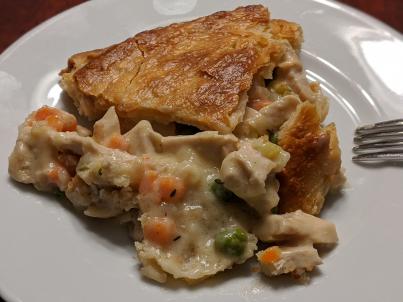
Chicken Pot Pie
- 1½ lbs chicken breast
- 1 cup finely chopped celery
- ⅔ cup butter
- ½ onion, finely chopped
- ⅔ cup flour
- 2 14.5 oz cans chicken broth
- 2 cups milk
- ¾ tsp salt
- ¼ tsp thyme
- 1⅓ cups chopped baby carrots
- ⅔ cup sweet peas
- 2 pie bottom crusts in pie tins
- 2 pie top crusts
- beaten egg or heavy cream to brush
Preheat oven to 425°F.
Pan fry the chicken breasts in a small amount of neutral
oil or butter, slicing lengthwise once firm enough to
decrease thickness and increase surface area. Cool and
chop into small pieces, about 2 cups.
In the remaining oil/butter and fond, sauté the chopped
celery until soft and browned, deglazing with mirin,
chicken broth, or just water, and set aside.
Melt butter in saucepan and add the chopped onion. Sauté
until soft, then reduce heat before adding the flour.
Stir until well incorporated, then increase heat and cook
for a few minutes before beginning to add the broth in
small amounts while stirring in order to form a roux.
Add the milk, salt, and thyme, and continue to cook for
several minutes more to make sure the flour is fully
cooked and the sauce is well developed.
Microwave the carrots until they begin to soften, about
3 minutes, then add the chopped chicken, celery, carrots,
and peas to the pan and continue to cook for a few more
minutes while the flavors combine.
Divide the mixture between the bottom crusts in pie tins,
then cover with the top crusts and crimp the edges. Brush
either a beaten egg (for better results) or heavy cream
(potentially easier) over the top crusts, then cut a few
slits in the top crusts.
Bake for 30-40 minutes or until crust is golden brown
and sauce begins bubbling out.
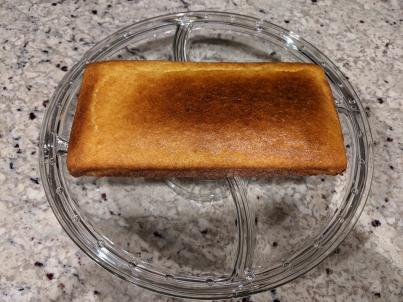
Cornbread
- 1 cup flour
- 1 cup corn meal
- ⅔ cup sugar
- 1 tsp salt
- 3½ tsp baking powder
- 1 egg
- 1 cup milk
- ⅓ cup vegetable oil
Preheat oven to 400°F.
Cut parchment paper to fit 1 9" cake pan or
2 8" loaf pans, to allow lifting the cornbread
out after baking. Alternately, thoroughly grease several
muffin trays.
Combine dry ingredients, then add remaining ingredients
and mix well.
Pour batter into pan(s) so that it is no deeper than an
inch or so, or fill muffins only about ⅔ of the way.
Bake for 20-25 minutes or until a toothpick poked to the
center of the cornbread comes out clean, and the surface
of the cornbread is just starting to brown around the
edges and is a medium yellow color elsewhere.
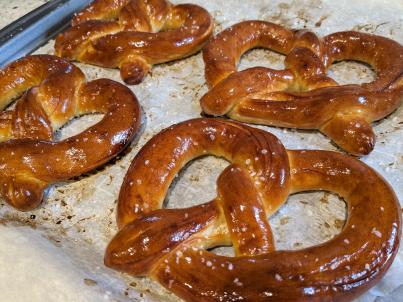
Soft Pretzels
- 1½ cups warm water
- 1 tsp sugar
- 4 tsp yeast
- 640 g (about 5 cups) flour
- ¼ cup sugar
- 1½ tsp salt
- 1 Tbsp vegetable oil
- 2 Tbsp baking soda
- 1 cup hot water
- ½ cup butter
- kosher salt
Dissolve yeast and sugar in warm water. Let stand until
creamy, about 10 minutes.
Thoroughly combine flour, sugar, and salt, then add oil and
yeast mixture and mix into a dough.
Knead the dough until smooth, about 7-8 minutes, adjusting
with a little more water or flour if it's too dry or too wet.
Place the dough in a lightly oiled bowl, turning to coat,
and cover with plastic wrap. Let rise in a warm place until
doubled in size, about an hour.
Preheat oven to 450°F.
In a shallow dish, dissolve baking soda in hot water and set
aside. Melt the stick of butter and get a pastry brush ready.
Turn risen dough out onto a lightly floured surface and
divide into 12 equal pieces.
Roll each piece into a rope about 1 cm in diameter, as evenly
as possible. Twist into pretzels, and dip each pretzel into
the baking soda solution before placing on baking sheets.
Bake until browned, about 8 minutes. Generously brush with
butter immediately after removing from oven, and sprinkle with
kosher salt.
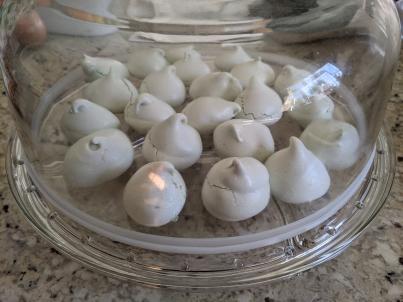
Meringues
- 4 egg whites
- ½ tsp cream of tartar
- ⅛ tsp salt
- 1 cup sugar
- 1 tsp vanilla extract, or other flavors
- parchment paper
- a lot of patience
Preheat oven to 225°F and line two large cookie sheets
with parchment paper. Set aside.
Combine egg whites, cream of tartar, salt, and sugar in the
bowl of a stand mixer, and use the whisk attachment to stir
on low speed until well mixed.
Allow the sugar to slowly dissolve, stirring occasionally,
until most of the sugar crystals are gone. The mixture will
not clear up entirely, but most of the sugar will dissolve.
Beat on high until thick, shiny, and significantly increased
in volume. Mixture should have very stiff peaks and all sugar
should be dissolved, much like marshmallow fluff spread.
Stir in vanilla extract, or any other extracts, flavoring
powders like cocoa, or colors desired. For cocoa, use about
2-3 Tbsp.
Fill a piping bag or plastic bag with one corner cut off
with the mixture, and form meringue shapes on the prepared
cookie sheet, close together as they will not spread, and
should all be baked in a single batch.
Bake for 1½-2 hours. Turn off the oven once the baking
time has elapsed, and leave the oven door closed to allow
cookies to cool completely in the oven (1-2 additional hours)
before removing.

Crème Brûlée
- 2 cups heavy cream
- ⅛ tsp salt
- 1 tsp vanilla extract
- 5 egg yolks
- ⅓ cup sugar
- 4-6 ramekins
Preheat oven to 325°F.
In a saucepan, combine cream and salt and cook over low heat
until hot, but not boiling. Remove from heat and add the
vanilla extract.
Beat yolks and sugar together until homogenous. Slowly add
about a quarter of the hot cream into this mixture, stirring
constantly, then pour sugar-egg mixture back into cream and
stir.
Pour into ramekins and place ramekins in a baking dish. Fill
dish with boiling water halfway up the sides of the
ramekins. Bake for 30 to 40 minutes, or until centers are
barely set.
Cool completely and refrigerate for several hours. When
ready to serve, top each custard with about a teaspoon of
sugar in a thin layer. Place ramekins in a broiler 2-3" from
heat source and cook until sugar browns or even blackens a
bit, about 2 minutes.
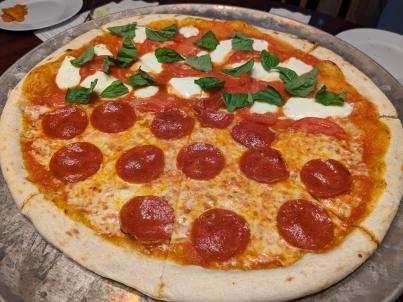
Pizza
Sauce and Toppings
- 1 28 oz can san marzano tomatoes
- ½ tsp salt
- 2 tsp crushed garlic
- 1 Tbsp olive oil
- 1 pound low moisture whole milk mozzarella
- other toppings as desired
- pizza stone or steel, pizza peel, corn meal
Dough
- 1½ cups warm water
- 2 tsp sugar
- 2 tsp yeast
- 4 tsp olive oil
- 1 tsp salt
- 575 g (about 4½ cups) bread flour
Combine water, sugar, and yeast, and let bloom for several
minutes. Add olive oil, salt, and flour, and knead either by
hand or in a stand mixer until smooth and elastic, and tacky
but not sticky.
Divide dough into 3 equal pieces (about 320g
each) and place in oiled containers big enough to allow them
to double in size, rolling each piece to lightly cover with
oil.
Refrigerate for at least 12 hours and up to a week, allowing
it to develop flavor and do other science magic.
Combine all sauce ingredients and blend until smooth. This
is enough sauce for about 6-7 pizzas, but the
tomatoes are generally only available in this size can. Extra
sauce can be used for dipping crusts, or saved for future
pizza.
Shred the mozzarella and refrigerate. Keep it cold until
immediately before use, even returning the container to the
refrigerator between pizzas. This is about the right amount
of cheese for 2-3 pizzas.
Place a pizza stone or steel in the oven near the top,
leaving enough room to slide pizzas in on a peel. Preheat
oven on the broil setting as hot as it will go, often either
500°F or 550°F, for at least an hour.
One at a time, lightly dust each dough ball with flour,
flatten to form a pizza shape, place it on the peel on top
of a small amount of corn meal, spread sauce on it, and add
cheese and other toppings. Flattening the dough takes some
practice; consult videos online for tips if necessary.
Jostle the pizza peel to make sure the pizza will release,
then slide into the oven and immediately set the oven to
bake instead of broil. Bake for about 6 minutes or until
the crust is beginning to brown, but the cheese has not yet
started to burn.
Remove the pizza and set on a rack to cool before slicing.
Remove excess corn meal from the oven, and set to broil
again. Allow at least 10-15 minutes before baking the next
pizza, so the pizza stone or steel can reheat.
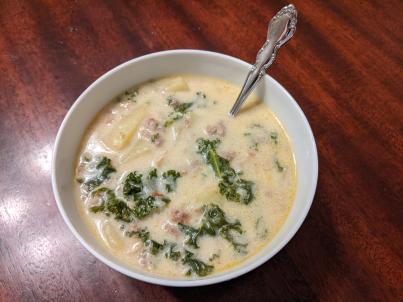
Zuppa Toscana
- 1 lb Italian sausage
- ½ cup lard or butter
- 1 onion, finely chopped
- 3 Tbsp minced garlic
- ½ cup flour
- 5 14.5 oz cans chicken broth
- 1 cup water
- 2-3 large Russet potatoes
- 1 cup heavy cream
- 1 cup milk
- 6 cups kale leaves
- 8 slices crispy bacon
Brown the sausage in a large pan and break it into small
chunks, no more than 1 cm in diameter. Set aside.
In the same pan, and with the residual oil and fond, melt
lard/butter, then add onion and garlic and cook until the
onion is translucent and soft.
Add flour and continue cooking several minutes, then add
chicken broth slowly, stirring to form a roux.
Transfer to a larger pot, then add water and continue
cooking to bring back to a boil.
Peel and slice the potatoes, about ½ cm thick and cut
into quarters. Add potatoes to pot and continue cooking.
Carefully wash kale, remove leaves from the stems, and
break leaves into pieces no larger than about 3 cm.
When potatoes are beginning to soften, add sausage, cream,
milk, and kale pieces.
Cook until the kale has wilted, then add bacon, chopped
into small bits. Stir and serve.
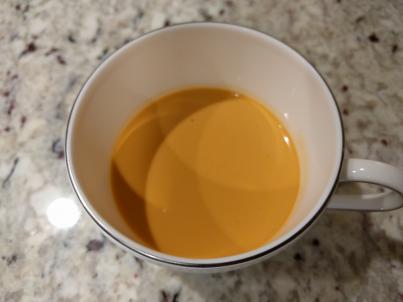
Panna Cotta
- 1 packet (about 7 g) gelatin
- ½ cup sugar
- 2 cups milk, divided
- 2 Earl Grey tea bags
- 2 cups heavy cream
In a small saucepan, combine the gelatin and sugar, then add
half of the milk and bring to a boil, stirring constantly.
In a separate saucepan, bring the remaining milk to a boil,
and add the teabags.
Once the tea has steeped enough to color the milk a medium
tan color, remove the teabags and combine both milk mixtures.
Mix in the heavy cream, and pour through a fine strainer to
remove any milk skins or gelatin pieces.
Pour into individual size serving cups and refrigerate for at
least an hour.
Alternate boozy flavorings: about 3 oz Irish cream,
or 1 oz dark rum or Grand Marnier.
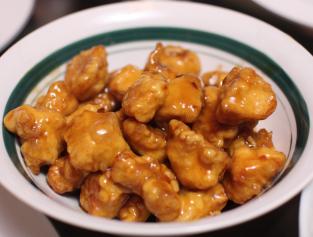
General Tso's Chicken
Sauce
- ½ cup sugar
- ¼ cup soy sauce
- ⅓ cup white vinegar
- 1 tsp red pepper flakes
- 1¼ cups water
- 3 Tbsp corn starch
Chicken
- 3 eggs
- ⅔ cup corn starch
- 1½ lbs chicken thighs
- flour
- deep fryer
Combine all glaze ingredients in a saucepan, mix thoroughly,
and set aside.
Trim fat and gristle from chicken thighs and cut into small
morsels, about 1" in size.
Beat eggs and corn starch together, then add chicken and mix
to cover.
Dredge each chicken piece in flour and drop into a deep fryer
at 375°F, letting the batch fry for about a minute once
full. Repeat until all chicken has been fried.
Cook glaze over low heat, stirring constantly, until mixture
thickens and is no longer cloudy. Continue stirring a little
longer after it first thickens; it will continue to thicken
for a while yet.
Combine all chicken and fry for about 1-2 additional minutes
to reheat and crisp the breading, then immediately pour glaze
over chicken, stir to cover, and serve.
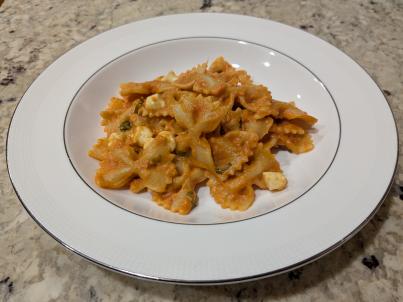
Vodka Pasta
- 4½ tsp olive oil
- 2 tsp minced garlic
- 1 28 oz can crushed tomatoes
- 1 oz vodka
- 1 tsp corn starch
- 1 Tbsp water
- 10 large leaves fresh basil
- ¾ cup heavy cream
- ½ lb farfalle or mini farfalle
- 4 oz ciliegine mozzarella
In a medium size pot, sauté garlic in olive oil until
softened, then add crushed tomato, vodka, and corn starch
mixed with water. Simmer, uncovered, about 10 minutes.
Julienne basil and add to sauce. Continue simmering until
basil has wilted.
Cook farfalle according to directions on box, often about 12
minutes.
Add cream and cooked farfalle to sauce and stir to combine.
If including ciliegine mozzarella, cut each in half, then fold
all into pasta, stirring minimally to avoid stretching as the
cheese softens.
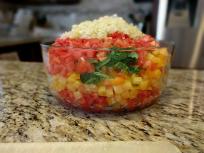
Bruschetta
- 2-3 shallots, thinly sliced
- 1 Tbsp minced garlic
- 4 Tbsp olive oil
- 3-5 large heirloom tomatoes
- 2 oz rice vinegar
- 2 oz red wine vinegar
- 20 large leaves fresh basil
- 2 baguettes
Sauté shallots and garlic in olive oil until softened,
then set aside.
Dice tomatoes and add to a large bowl. Add vinegars, and
shallot and garlic mixture.
Julienne basil and add to bowl. Mix thoroughly, then cover
and refrigerate at least 2 hours, ideally overnight.
Thinly slice baguettes and store in an airtight container
until ready to serve.
Let bruschetta warm to room temperature before serving, then
toast baguette slices and serve with bruschetta.
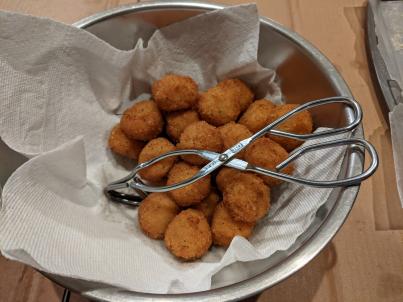
Saffron Arancini
- 5 cups chicken broth
- 2 pinches saffron
- 2 Tbsp butter
- ½ onion, finely chopped
- 1 cup short-grain rice
- ¼ cup dry white wine
- ⅓ cup grated Monterey Jack cheese
- bread crumbs
- deep fryer
Bring chicken broth just to a boil, then reduce heat to keep
hot. Add saffron to 1 cup hot broth in a separate
container and let soak.
Melt butter in saucepan and add chopped onion. Sauté until
soft, then add rice, uncooked, and stir occasionally until
rice becomes more chalky in appearance, about 5 minutes.
Add wine and stir until alcohol boils off, then add saffron
broth mixture and stir until liquid is absorbed and a flat
spatula can leave a clean path behind it while stirring.
Add remaining broth in small amounts, about ½-⅔
cup at a time, stirring after each addition until liquid is
absorbed, as before.
Add cheese and stir to melt and thoroughly incorporate, then
refrigerate until chilled and firm, about 1-2 hours.
Form into 1" balls and roll each ball in bread crumbs to
completely cover.
Arrange balls in a single layer in the basket of a deep
fryer, then fry each batch at 375°F for about 2 minutes
until golden brown and crispy. Alternately, freeze balls
and fry later, increasing time to about 3 minutes.
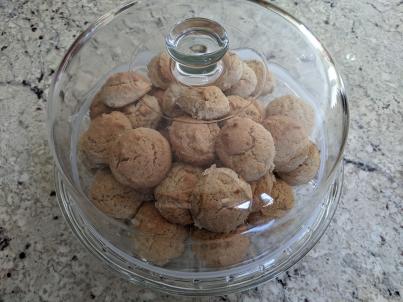
Spice Cookies
- ¾ cup butter
- 1½ cups sugar
- 1¼ tsp vanilla extract
- 2 eggs
- ½ tsp salt
- ½ tsp baking soda
- 2 tsp baking powder
- ½ tsp cloves
- ½ tsp nutmeg
- 1 tsp cinnamon
- 3½ cups flour
- ½ cup sour cream
Cream butter until soft, then add sugar, creaming until
light. Add vanilla and eggs and mix thoroughly.
Combine salt, baking soda, baking powder, spices, and flour,
and add to butter mixture in thirds, alternating with sour
cream. Chill, covered, for at least 2 hours.
Preheat oven to 375°F.
Form into portions about 1½-2 Tbsp, roughly ball-shaped
but not rolled or smoothed out, for a rough final texture.
Bake for 10 minutes or until light brown on edges.
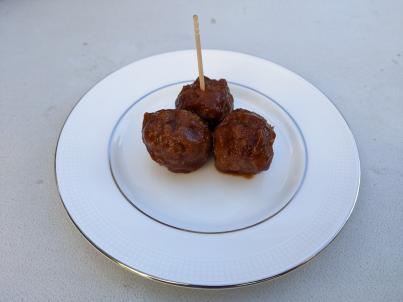
Cocktail Meatballs
Sauce
- 1½ cups ketchup
- 1 cup water
- ½ cup white vinegar
- ⅔ cup packed brown sugar
- 3 Tbsp onion powder
- 2 tsp mustard powder
- 8 tsp Worcestershire sauce
Meatballs
- 2 lbs ground beef
- 4 eggs
- 2 cups rolled oats
- ¼ cup onion powder
Preheat oven to 325°F.
In a large bowl, combine ground beef, eggs, rolled oats, and
onion powder. Mix well and form into 1 inch meatballs.
Bake for 30 minutes on a baking sheet.
Meanwhile, in a slow cooker, combine the ketchup, water,
vinegar, brown sugar, onion powder, mustard powder, and
Worcestershire sauce, and mix thoroughly.
Remove meatballs from oven and add to slow cooker, gently
stirring to coat evenly.
Cook for at least 1 hour before serving, gently stirring
occasionally.
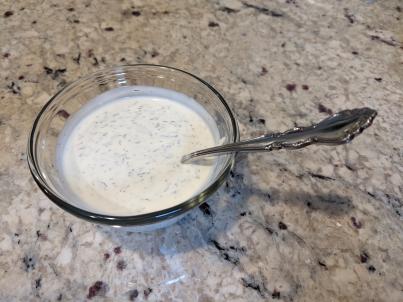
Dill Dressing
- ½ cup mayonnaise
- 2 Tbsp white vinegar
- ¼ tsp sugar
- 1½ tsp dill
Combine all ingredients and mix thoroughly. Chill for
several hours before using.
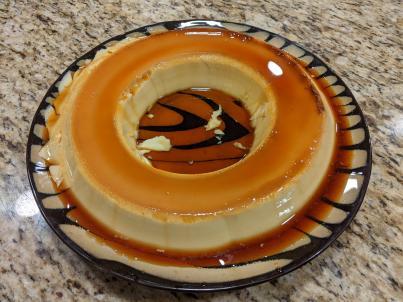
Flan
- 3 cups milk, divided
- ⅔ cup sugar for flan plus about ¼ cup for caramel
- 0.3 ml anise extract, 3 star anise, or ¾ tsp anise seed
- 6 eggs
- 1 Tbsp vanilla extract
- ½ oz dark rum
- high-rimmed baking sheet or casserole
- heat diffusion disc
- flan mold
Preheat oven to 300°F and set up a water bath. The
water bath should come almost to the top of the flan mold.
Combine 1 cup milk with the sugar and anise and
heat just shy of boiling to fully dissolve the sugar. Set aside
to cool, removing the star anise or seeds if applicable.
Coat the bottom of the flan mold with sugar, about
¼ cup, then heat to melt and slightly
caramelize the sugar. Use a heat diffusion disc to ease.
Set aside to cool.
Beat eggs and combine with remaining milk, vanilla, and
cooled milk/sugar/anise mixture. Pour over cooled sugar in
flan mold.
Bake in water bath for 45-50 minutes. Flan is done when
poking it produces only slight jiggles.
Cool flan completely before unmolding.
Run a knife around the edges of the mold, put an inverted
plate over the mold, and invert together with the mold.
Drizzle with rum and serve.
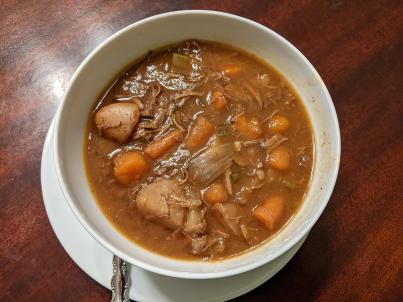
Beef Stew
- 3 lbs beef, cubed
- 1 bottle red wine
- 2 14.5 oz cans beef broth
- 1 Tbsp tomato paste
- 2 tsp crushed garlic
- 1 tsp salt
- 3 cups chopped onions
- 3 cups chopped carrots (baby carrots work well)
- 3 cups chopped celery or bok choy
- 3 cups chopped red potatoes
- 6 bay leaves
- 3 Tbsp corn starch
- slow cooker liner
Sear the beef so all pieces are browned on all sides, and
add to a slow cooker, optionally lined with a slow cooker
liner for easier cleanup later.
Deglaze the pan used for searing with some of the red wine,
then add all red wine to the slow cooker as well.
Add beef broth, tomato paste, garlic, and salt to the slow
cooker.
Chop the onion into small pieces, not quite minced but
small enough to fit comfortably on a spoon, and add to the
slow cooker.
Chop carrots, celery or bok choy, and potatoes similarly,
and add to the slow cooker.
Stir slow cooker contents to distribute ingredients evenly,
add the bay leaves, and set slow cooker for 6 hours.
Very occasionally, stir to redistribute ingredients and
make everywhere near the slow cooker smell amazing.
When cooking is done, remove and discard bay leaves, then
remove 2 cups of liquid to a small pot.
Let removed broth cool slightly, add corn starch, and heat
until thickened, stirring constantly. Set aside.
Remove about 1½ cups of vegetables (but
not beef) to a blender, plus an equal amount of broth, and
purée. Add purée to the thickened broth.
Remove a final batch of liquid from the slow cooker to
rinse the blender, pour the thickened broth back into the
slow cooker, and pour the blender broth into the pot to
rinse it as well. Add all back to the slow cooker and stir
to thoroughly combine.
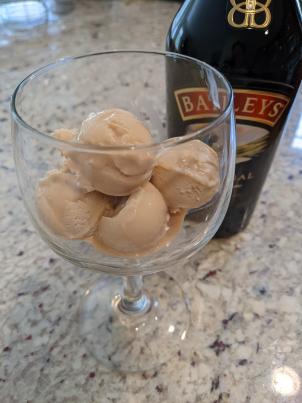
Irish Cream Ice Cream
- 1 cup heavy cream
- 1 cup whole milk
- 2 Tbsp sugar
- 2 Tbsp brown sugar
- ½ tsp vanilla extract
- 2 oz Irish cream
- ice cream machine
Combine all ingredients and mix thoroughly to completely
dissolve sugars.
Add mixture to ice cream machine and freeze to ice cream.
Makes about 4 servings.
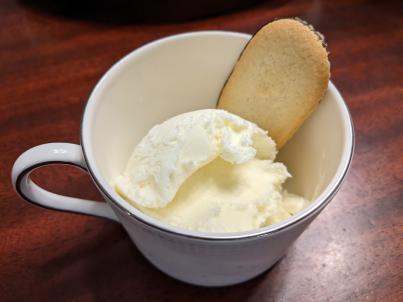
Tea-free Earl Grey Ice Cream
- ¾ cup heavy cream
- ¾ cup whole milk
- ¼ cup sugar
- 1 drop bergamot oil
- ice cream machine
Combine all ingredients and mix thoroughly to completely
dissolve sugar.
Add mixture to ice cream machine and freeze to ice cream.
Makes about 3 servings.

Basil Ice Cream
- 1 cup heavy cream
- 1 cup whole milk
- ⅓ cup sugar
- 2 egg yolks
- 40 grams fresh basil leaves
- ice cream machine
Combine cream, milk, sugar, and egg yolks, then stir
constantly over low heat just until steaming and slightly
thickened. Remove from heat and cool.
Trim basil to remove large central veins, then blend with
milk mixture until homogeneous. For best results, avoid
introducing air during blending by appropriate choice of
blender and/or method of use.
Add mixture to ice cream machine and freeze to ice cream.
Makes about 4 servings.
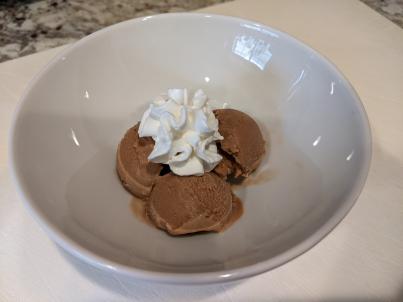
Chocolate Malt
- ¼ cup sugar
- 2 Tbsp malted milk
- 2 Tbsp hot chocolate powder
- 1 cup whole milk
- 2 Tbsp chocolate syrup
- ½ tsp vanilla extract
- 1 cup heavy cream
- ice cream machine
Combine sugar, malted milk, and hot chocolate powder, then
add milk and mix thoroughly to completely dissolve sugar and
incorporate chocolate powder.
Add remaining ingredients and mix until homogeneous.
Add mixture to ice cream machine and freeze to milkshake
consistency. Makes about 4 small (⅔ cup) servings.
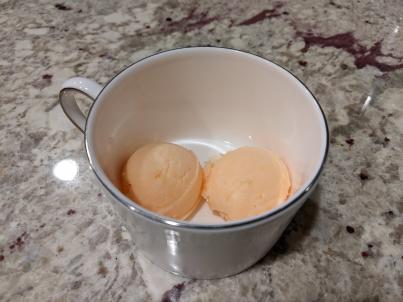
Orange Sherbet
- 2 cups orange juice
- ¼ tsp orange extract or 1 Tbsp orange zest
- 1 cup sugar, divided
- ½ cup heavy cream
- ½ cup milk
- orange food coloring
- ice cream machine
Combine orange juice, extract or zest, and ⅔ of the
sugar, then mix thoroughly to completely dissolve sugar.
In a separate container, combine remaining sugar and heavy
cream, and whip to soft peaks.
Add milk to orange juice mixture, then fold in whipped
cream. If adding coloring, add with whipped cream.
Add mixture to ice cream machine and freeze. For best results,
freeze for several hours or overnight in a freezer as well.

Alfredo Sauce
- 6 Tbsp butter
- 1½ cups heavy cream
- 1 tsp crushed garlic
- 1 cup freshly grated parmesan cheese
Melt butter in a wide pan over low heat, then add cream,
stirring briskly to homogenize.
Add garlic and simmer for about 5 minutes to reduce,
stirring occasionally.
Add grated cheese little by little, stirring to melt and
combine between additions.
Add pasta and/or other food directly to pan, toss to coat,
and serve immediately.
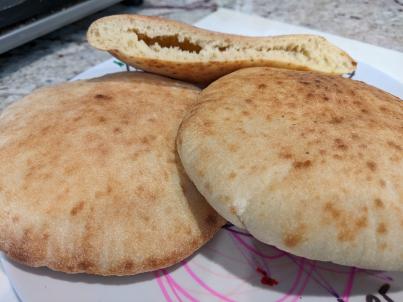
Pita Bread
- 364 g warm water
- 9.2 g yeast
- 18 g salt
- 1 Tbsp olive oil
- 607 g (about 4¾ cups) bread flour
- pizza oven
Combine water and yeast, and let bloom for several minutes.
Add salt and olive oil, then add to flour, and knead either by
hand or in a stand mixer until smooth and elastic, and tacky
but not sticky.
Cover and let rise in a warm place for about two hours, until
doubled in size.
Punch down and divide into 8 equal pieces (about
125g each) and place in separate covered containers. Let rise
in a warm place for about a half hour more.
Roll out each dough ball to a uniform thickness of about
½ cm, using extra flour to prevent sticking.
Place in thoroughly preheated pizza oven, and allow to inflate
and brown before removing, about 1-2 minutes. To prevent
premature browning before inflation it may be necessary to
temporarily turn off the pizza oven until inflated.
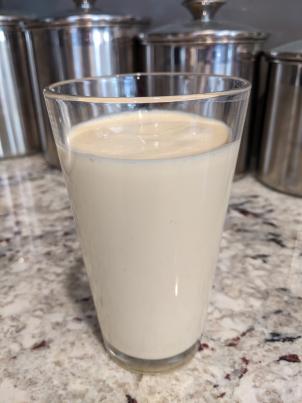
Egg Nog
- 1 cup heavy cream
- 3 cups milk
- 6 Tbsp sugar
- ½ tsp nutmeg
- 4 eggs
- 1½ oz dark rum
Combine all ingredients in a blender and blend until
homogeneous.
Note that the eggs remain raw; use appropriatedly-sourced
eggs for safety.
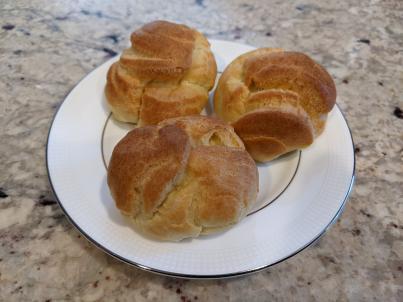
Cream Puffs
Pastry Cream
- ½ cup sugar
- ¼ tsp salt
- 3 Tbsp corn starch
- 4 egg yolks or 3 whole eggs
- 2 cups milk
- 2 tsp vanilla extract
- 1 Tbsp butter
- 1½ oz baking chocolate
Puffs
- ½ cup butter
- ½ cup water
- ½ cup milk
- ¼ tsp salt
- 2 tsp sugar
- 1 cup flour
- 4 eggs, beaten
Thoroughly combine sugar, salt, and corn starch, then add egg
yolks or eggs and beat together with dry ingredients until
homogenous. Set aside.
Combine milk and vanilla in a saucepan and bring to a simmer.
Slowly add hot milk mixture to egg mixture, stirring constantly
but not frantically, tempering the eggs. Transfer tempered egg
mixture back to saucepan.
Cook over low heat, stirring or whisking constantly, until it
just begins to thicken. Remove from heat and continue stirring
while residual heat finishes thickening.
Add butter and continue stirring until completely incorporated.
If making chocolate pastry cream, add chocolate a little at a
time and stir gently until melted and incorporated before adding
more. Chill for several hours before using.
Preheat oven to 400°F and set a shallow pan of water inside
to keep the environment humid for the puffs while baking.
Combine butter, water, milk, salt, and sugar in a saucepan and
bring to a simmer. Reduce heat to low, then add flour and
stir thoroughly until a thick paste forms. Continue stirring
and pushing against the bottom of the saucepan for an
additional minute or two to fully cook the flour.
Transfer to a stand mixer with the paddle attachment and stir on
low speed for several minutes to cool slightly. Slowly add
beaten eggs in several separate additions, allowing the egg
to fully incorporate between each addition. Stop adding egg
once the mixture becomes glossy and starts to pull away from
the bowl cleanly.
Transfer to a piping bag or plastic bag with corner cut out, then
pipe into 2 inch dollops about 3 inches apart on a sheet of
parchment paper.
With wet fingers, pat down the tops of the dollops to make them
round, then optionally brush with egg wash for a glossier final
appearance.
Bake for 20 minutes, then without opening the oven, reduce
temperature to 350°F and bake for 10 minutes more. Cool
before filling with pastry cream.

Citrus Fizz ("Pussyfoot")
- ¾ cup orange juice
- 2 Tbsp lemon juice
- 2 Tbsp lime juice
- 2 Tbsp grenadine
- 2 eggs
- ¾ cup lemon lime soda
Combine juices, grenadine, and eggs in a cocktail shaker and
shake to thoroughly homogenize.
Add ice and shake again for 30 seconds or so, then add soda
and stir gently before straining to serve.
Note that the eggs remain raw; use appropriatedly-sourced
eggs for safety.
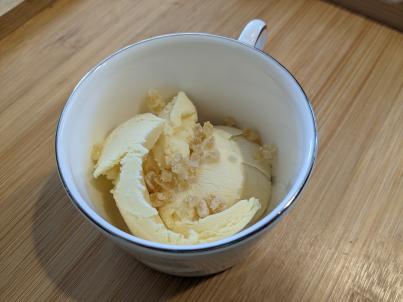
Ginger Ice Cream
- 1½ cups heavy cream
- 1½ cups whole milk
- ⅔ cup sugar
- ⅛ tsp salt
- 1 cup chopped ginger
- 4 egg yolks
- ¼ cup finely chopped candied ginger
- ice cream machine
Combine cream, milk, sugar, and salt in a saucepan and bring
to a simmer, then add chopped ginger and stir. Cover and let
steep for 1 hour.
Strain out ginger pieces, then return to a simmer and slowly
add about ⅓ of milk mixture to egg yolks while whisking
constantly, then add back to remaining milk mixture.
Cook until thickened, then strain again, cover, and cool for
several hours before churning to ice cream.
If adding candied ginger, add just after churning and before
freezing, or serve with candied ginger as a garnish.
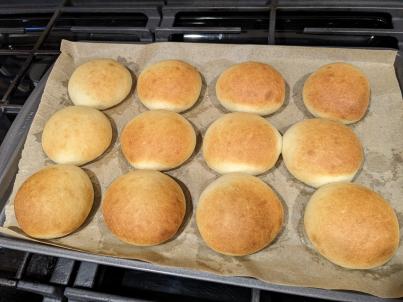
Dinner Rolls
- 1¼ cups warm water
- 2 Tbsp sugar
- 4½ tsp yeast
- 1 Tbsp vegetable oil
- 3¼ cups flour
- 1 tsp salt
- ½ tsp baking powder
- melted butter
- parchment paper
Combine water, sugar, yeast, and oil. Let stand until creamy,
about 10 minutes.
Add flour, salt, and baking powder, and knead until smooth,
about 10 minutes.
Form into 12 rolls, about 65 g each, and set on
a sheet of parchment paper on a baking tray. Gently press down
to flatten each for a bun-like shape after baking. Cover and
let rest for about 20 minutes.
Preheat oven to 395°F.
Optionally brush with melted butter, then bake for 10 minutes
or until golden brown. Alternately, bake under an inverted
aluminum tray sprayed with a fine mist of water for extra
oven spring without a greasy surface.
Optional alteration: decrease to 1 cup warm water
and 3 cups flour, but combine ¼ cup
milk, ¼ cup flour, and 1 Tbsp
butter or vegetable oil and cook while stirring until a
paste forms, then add to other ingredients before kneading to
form a tangzhong style bun that will keep longer.
Optional alteration: increase to 6 Tbsp sugar and
add ⅜ tsp saffron powder for saffron rolls.
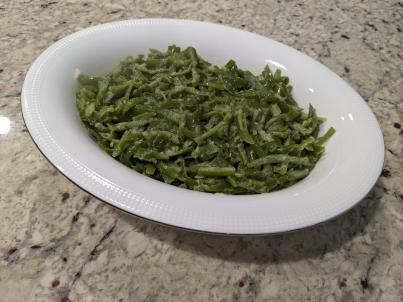
Garlic Green Beans
- 1 lb french cut green beans
- ¼ cup butter
- 1 Tbsp crushed garlic
- ½ tsp garlic powder
- 1 tsp onion powder
- ⅛ tsp salt
- ⅛ tsp MSG
Combine all ingredients and sauté until thoroughly mixed and
the butter has emulsified with liquid from the beans into a
sauce that coats the beans, about 10 minutes.

French Fries
- 10 lbs Russet potatoes
- 1 gallon water
- 4 Tbsp white vinegar
- salt to taste
- vegetable slicer
- deep fryer
Peel the potatoes, setting peeled potatoes in a bowl of
water to prevent browning.
Slice the potatoes into fry shapes, 1 cm square, optionally
using a vegetable slicer dedicated to this task for more
uniform fries. (Note that the fries will shrink considerably,
so don't cut the fries to the desired final dimensions at
this step.) For best results, keep only the longer, full
thickness cuts from the center of each potato, using the
others for another dish, like Zuppa
Toscana or mashed potatoes. Place cut fries in another
bowl of water, or two separate bowls if separating the best
fries from other slices destined for a different use.
Add to a large pot, cover with 1 gallon fresh water,
add the vinegar, and bring to just shy of a boil. Turn off
heat, cover, and let sit for about 15 minutes to par-boil.
Drain, then deep fry in small batches at 375°F for 5-7
minutes each. Be prepared for a large amount of boiling just
after immersing each batch in the fry oil, which will subsude
after a minute or so.
As each batch completes, arrange fries carefully on a tray so
each fry is straight, not bent over other fries or otherwise
contorted, with minimal contact with other fries. A "Lincoln
Log" pattern works well.
Once all fries have been fried and arranged, freeze fries
overnight, then separate all fries and move to an airtight
container for longer-term frozen storage.
To prepare fries to eat, fry again at 375°F for 6-8
minutes, toss with salt to taste, and serve immediately.
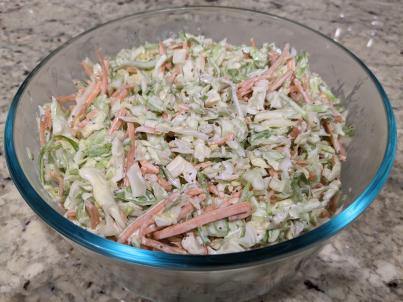
Cole Slaw
- 1½ cups mayonnaise
- 3 Tbsp apple cider vinegar
- 1 Tbsp lemon juice
- 1 Tbsp honey
- 1½ tsp celery seed
- ½ tsp salt
- 20 oz shredded cabbage
- 5 oz shredded carrots
Combine mayonnaise, vinegar, lemon juice, honey, celery seed,
and salt, and mix thoroughly.
Add cabbage and carrots and toss to completely coat and evenly
distribute carrots into cabbage. Refrigerate at least overnight
and ideally a full day or more before serving.
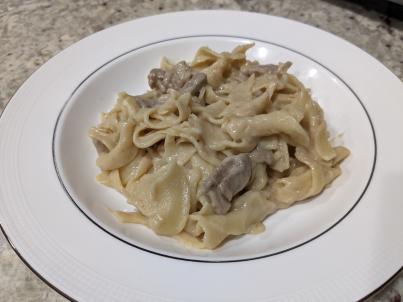
Beef Stroganoff
- 1½ lbs beef tenderloin
- ½ onion, finely chopped
- ⅓ cup butter
- ⅓ cup flour
- 3 cups beef broth
- 1 lb wide egg noodles
- ½ cup sour cream
- ¾ tsp dijon mustard
Trim the beef, saving the trimmings for the next step, and
cut the trimmed beef into small, thin pieces.
In a large saucepan, sear the beef trimmings until fragrant
and some of the fat has rendered out, leaving oil and fond
in the pan. Discard trimmings.
While the saucepan is still hot but with the heat off, toss
the beef pieces in the oil, allowing the outside of each
piece to lightly brown, but not cook through. Remove from
pan and set aside.
Add onion and butter to the saucepan and sauté until soft.
Add flour and stir for 1-2 minutes more, then add beef
broth, stirring constantly to avoid lumps.
Set noodles cooking, often for about 6 minutes, contrary to
package instructions which may call for 7-9 minutes.
Purée sauce thoroughly, then return to pan and add sour
cream and mustard, stirring to combine before adding beef
pieces, together with any liquid that might have collected
while sitting.
Bring sauce just to a boil to finish cooking beef, then
pour over noodles once done cooking and drained. Toss to
cover, then serve immediately.
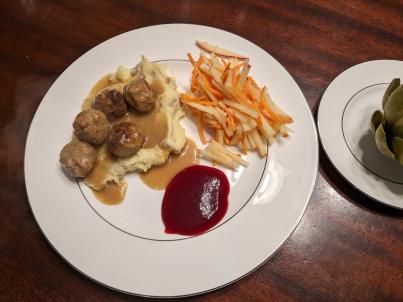
Swedish Meatballs
Meatballs
- ½ onion, finely chopped
- ½ cup milk
- ⅓ cup cream
- 1 egg
- 5 slices sliced white bread
- 1 lb ground beef
- 1 lb Italian sausage
- 2½ tsp crushed garlic
- 1 Tbsp salt
- 1⅛ tsp white or black pepper
- ⅜ tsp allspice
- ½ tsp nutmeg
Sauce
- 3 14.5 oz cans beef broth
- 2 tsp corn starch
- 1 Tbsp dijon mustard
- 4 tsp Worcestershire sauce
- 1 packet (about 7 g) gelatin
- ½ cup butter
- ½ cup flour
- ⅓ cup white wine
- ½ cup cream
Preheat oven to 500°F.
Add onion and a small amount of neutral oil to a saucepan and
sauté until soft.
Transfer to a bowl and add milk, cream, egg, and bread, torn
or chopped into medium-size pieces.
Mix thoroughly, then add beef, sausage, garlic, salt, and
spices, and mix again until homogeneous.
Form into 1 inch meatballs, then bake for 20 minutes, turning
halfway through so each meatball gets browned more evenly.
While meatballs are baking, thoroughly combine beef broth,
corn starch, mustard, and Worcestershire sauce, then add
gelatin and let soak until no dry gelatin remains.
Gently heat broth mixture until warm, and the gelatin has
dissolved.
Melt butter in a saucepan, then add flour and cook for several
minutes. Add wine, stirring vigorously until mixture is thick
and bubbling subsides.
Slowly add beef broth mixture while continuing to stir to
prevent lumps from forming, then add cream.
When meatballs are ready, carefully add to sauce without much
meatball grease. Turn to coat, then serve.
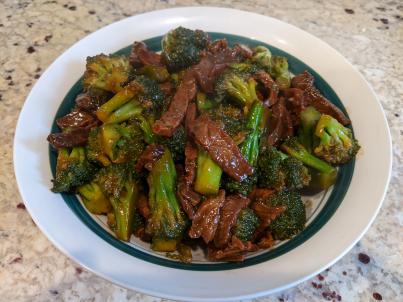
Beef with Broccoli
- 1 lb beef
- teriyaki sauce to marinate
- ⅓ cup water
- 1 Tbsp corn starch
- ⅓ cup teriyaki sauce
- ⅓ cup mirin
- 1 lb broccoli
Marinate the beef in teriyaki sauce for at least several hours,
then grill until rare or medium rare at most.
Combine water, corn starch, ⅓ cup teriyaki
sauce, and mirin in a large pan, then cook until thickened.
Slice beef into small medallions, then add with broccoli to pan
and turn to coat, cooking to finish beef to medium and heat
thoroughly.
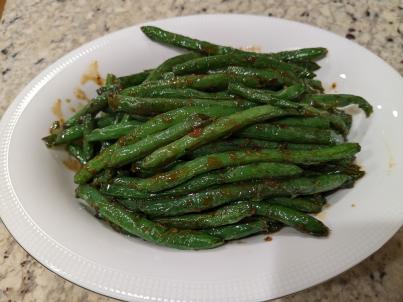
Szechuan Green Beans
- 1 tsp sugar
- ¼ tsp red pepper
- ¼ tsp black pepper
- ¼ tsp szechuan pepper
- 1 oz rice vinegar
- ¼ cup soy sauce
- 1 Tbsp minced ginger
- 1 Tbsp minced garlic
- 1 lb green beans
- deep fryer
Combine sugar and peppers and grind until fine with a mortar
& pestle, then add to a saucepan and add vinegar, soy
sauce, ginger, and garlic. Cook until thickened.
If using a deep fryer, fry green beans for 1-2 minutes until
just blistered but not completely softened. Otherwise, sauté
with a small amount of neutral oil until similarly cooked,
though it will take longer and likely will not achieve the
same external appearance.
Combine sauce and green beans and toss to coat.
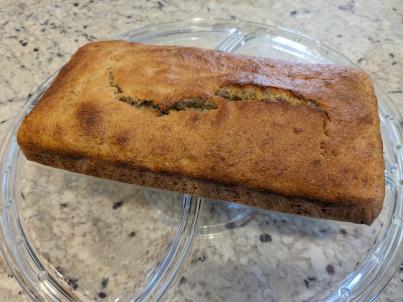
Banana Bread
- 4 bananas
- 1 cup sugar
- 6 Tbsp vegetable oil
- 2 eggs
- ¼ cup wheat germ or cream of wheat
- 2 cups flour
- 1 Tbsp baking powder
Preheat oven to 350°F.
Mash bananas, then add sugar, oil, eggs, and wheat germ or
cream of wheat. Mix until combined, then add flour and baking
powder and stir just until well mixed, but not more.
Cut parchment paper to fit two 8" loaf pans, to allow lifting
the bread out after baking. Divide batter between both pans.
Bake for 45-50 minutes, or until a toothpick pushed into the
loaf in the middle comes out clean, and the crust is deeply
browned and crispy.
Remove from loaf pans and let cool at least 5-10 minutes to
firm up before slicing.

Cucumber Salad
- 1 lb Persian cucumbers
- ½ tsp salt
- 8 tsp sugar
- 1 oz rice vinegar
- 3 Tbsp mirin
- 1 Tbsp toasted sesame oil
- 2 Tbsp vegetable oil
- 1 Tbsp minced garlic
- ¼ tsp chili oil
Slice cucmbers into 1.5 cm pieces, then sprinkle with salt
and sugar, and toss to thoroughly coat. Let sit for half an
hour, toss again, then let sit for another half hour.
Combine rice vinegar, mirin, oils, and garlic, then add to
cucumbers (without discarding the liquid that will have
developed) and toss to thoroughly coat all pieces.
Marinate at least 12-24 hours, tossing occasionally to give
all cucumber pieces time submerged in the liquid.
Drain before serving, then optionally add chili oil.
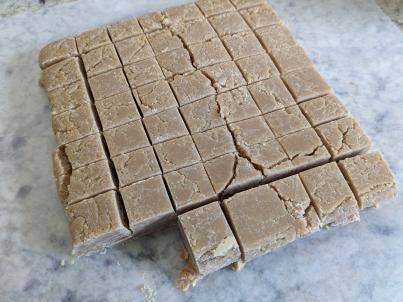
Peanut Butter Fudge
- 2 cups sugar
- ½ cup cream or milk
- 1 cup peanut butter
- 1 tsp vanilla extract
Combine sugar and milk in a saucepan and bring to a boil,
then continue cooking for 2-3 minutes more, while stirring
regularly.
Remove from heat and add peanut butter and vanilla, then
stir until homogeneous and smooth.
Pour into or onto a suitable vessel or surface to cool,
smoothing the surface and keeping the edges neat so it can
be sliced once cool.
Slice and store at room temperature for up to several
days, if any survives uneaten after the first day.
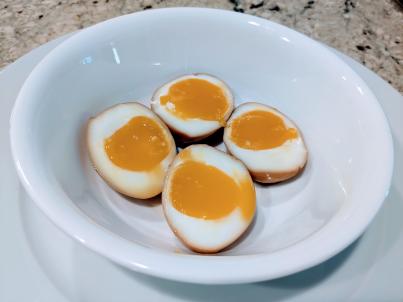
Flavored Eggs
- 6 eggs
- ½ cup water
- 6 Tbsp soy sauce
- 6 Tbsp mirin
- 1 tsp molasses
- thumbtack
Using a thumbtack, puncture the big end of each of the eggs,
then bring a pot of water to a boil and carefully lower the
eggs into the water.
Let eggs boil for 7 minutes, then remove from pot and plunge
into an ice bath to halt further cooking.
Combine water, soy sauce, mirin, and molasses, then peel eggs,
rinse, and submerge in marinade. For best results, use a plate
or some other object to keep eggs fully submerged.
Refrigerate and let eggs marinate for about 4 hours, then
remove, slice in half, and serve.
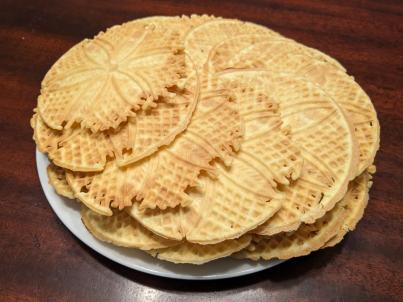
Pizzelles
- 3 eggs
- ¾ cup sugar
- ½ tsp anise extract
- ½ tsp anise seed
- 1 tsp lemon zest
- ½ cup softened butter
- 1¾ cups flour
- 2 tsp baking powder
- ¼ tsp salt
- pizzelle iron
Combine eggs and sugar and beat until light and fluffy, then
add anise, lemon zest, and butter, and beat until combined.
Combine remaining ingredients, then fold into egg mixture in
small increments until just incorporated and smooth, like a wet
and sticky cookie dough.
Dollop about 1 Tbsp per pizzelle in the pizzelle iron and cook
until golden brown and crisp, about 1 minute. Some irons may
need non-stick spray or oil brushed to avoid sticking.
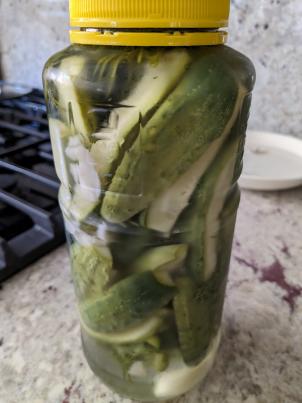
Pickles
- 4½ cups water
- 1½ cups white vinegar
- 2 Tbsp salt
- 1 tsp sugar
- sizeable handful of fresh dill
- 1 head of garlic
- 20 peppercorn kernels
- 10-12 pickling cucumbers
- 2 very clean mason jars
Combine water, vinegar, salt, and sugar, and bring to a boil.
Cover and let return to room temperature.
Remove thick stems from dill, and peel and lightly smash the
garlic cloves.
Slice cucumbers into spears or chips, then layer in jars with
dill, garlic, and peppercorns.
Pour brine to the top of each jar, screw on lids, and
refrigerate for about a week before use.

Roti
- 500 g flour
- 1 tsp sea salt
- 1 tsp sugar
- ⅔ cup hot water
- ⅔ cup water
- ⅓ cup butter
Combine flour, salt, and sugar, then add hot water and mix
until no liquid remains. Add room temperature water and mix
until homogeneous, then cover and let rest for about 20
minutes.
Knead dough briefly, then divide into 8 equal pieces,
covering all but each piece while working with it.
Spread a small amount of butter on a rolling pin and a smooth
work surface, then roll out each piece of dough to about 8" in
diameter and spread about 2 tsp of butter (a "pat" of butter)
on it. Carefully roll into a log, then coil the log into a
ball.
Let all dough balls rest another 20 minutes or so, then roll
each one out to about 7" in diameter on the same smooth work
surface before gently picking up and frying at low heat.
Slice into quarters and serve hot.
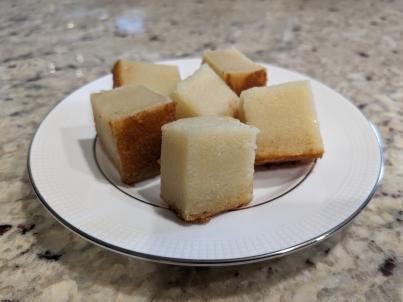
Butter Mochi
- ½ cup unsalted butter
- 16 oz mochiko flour
- 1½ cups sugar
- 2 tsp baking powder
- 4 beaten eggs
- 1 14 oz can coconut milk
- 1 12 oz can evaporated milk
- 1 tsp vanilla
Preheat oven to 350°F.
Warm butter just to the point of melting, but no further, and
set aside to add to the mixture later.
Grease a 9x13 inch baking dish and set aside.
Combine flour, sugar, and baking powder, then add beaten eggs
and mix thoroughly until mixture resembles wet sand.
Add coconut milk, then stir until homogeneous. Add evaporated
milk and stir again, until homogeneous again.
Add butter and vanilla, then stir one final time to combine.
Pour into greased pan and bake for 60-70 minutes or until
mochi jiggles only slightly when lightly jostled.
Let cool completely before slicing and serving.
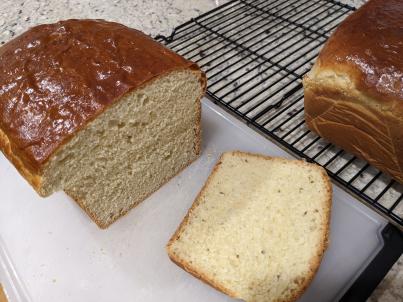
Sweet Bread
- ½ cup warm water
- 1 Tbsp sugar
- 4½ tsp yeast
- 1 cup butter
- 1¼ cups sugar
- 3 eggs
- 1 Tbsp anise seed
- ½ cup evaporated milk
- 800 g (about 6¼ cups) flour
Combine water, 1 Tbsp sugar, and yeast, and set aside.
Combine butter and sugar, then add eggs and anise. Mix thoroughly,
then add evaporated milk and about half the flour, again mixing until
homogeneous.
Add yeast mixture, mix thoroughly, then incrementally add remaining
flour, adjusting the amount as necessary, until dough is almost pulling
away from the sides of the container but still too sticky to knead.
Divide into 2 pieces and place in loaf pans lined with
parchment paper, then lightly cover and let rise in a warm place for
several hours.
Preheat oven to 325°F, then bake for 30-40 minutes, brushing the
tops with extra evaporated milk once or twice after at least 15-20
minutes of baking.
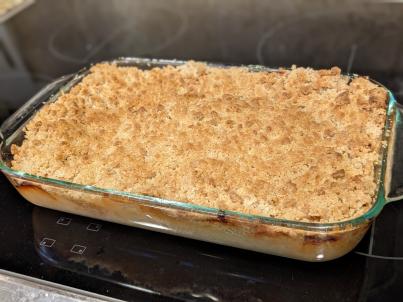
Apple Crisp
Topping
- 1 cup oats
- 1 cup flour
- 1 cup brown sugar
- ½ tsp baking powder
- ½ tsp cinnamon
- ¼ tsp nutmeg
- ¼ tsp salt
- ½ cup butter
Apples
- 6-8 Granny Smith apples
- 2 Tbsp lemon juice
- 2 Tbsp flour
- 1 Tbsp sugar
- ¼ tsp cinnamon
Preheat oven to 350°F.
Peel, core, and cut apples into slices or chunks around the size
of a cherry, then toss with lemon juice. Combine flour, sugar, and
cinnamon, then sprinkle over apples, toss to combine, and place
all in a 9x13 inch casserole and set aside.
Combine all topping ingredients but butter in a wide bowl. Slice
butter, still cold, into thin pats and add to sugar/flour mixture
several at a time, tossing to coat before adding more.
Break up butter pats by hand, incorporating sugar/flour mixture
as the butter is divided, until eventually the mixture resembles
clumpy wet sand and no fine powder remains.
Sprinkle topping over apples, coating evenly, then bake for 20-25
minutes. Near the end of baking, if topping is not yet browning,
set oven to broil for a few minutes.
Let cool slightly, then serve with ice cream for best effect.
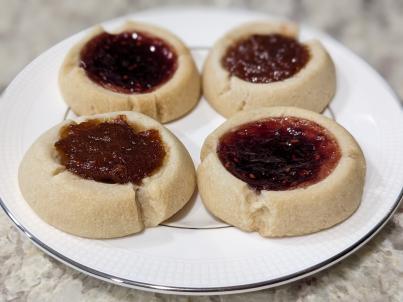
Shortbread Cookies
- ½ cup butter
- ½ cup powdered sugar
- 1 tsp vanilla
- 1¼ cups flour
- 8 tsp jam or marmalade
Thoroughly combine butter, sugar, and vanilla, then add flour and
mix until homogeneous. Let stand for at least 30 minutes.
Preheat oven to 300°F.
Divide into 16 cookies about 2 tsp each, optionally
creating an indent in the top of each cookie for about ½ tsp
jam or marmalade.
Bake for 24 minutes or until lightly browned and matte in texture.
Let cool slightly to firm up before removing from baking tray.
Mango Sorbet
- 1 cup sugar
- ⅛ tsp salt
- 1 cup water
- 3 Tbsp lime juice
- 1 oz white rum
- 2 lbs chopped mango
- ice cream machine
Completely dissolve sugar and salt in water, then add lime juice
and rum.
Add to blender, then add mango and blend until homogenous.
In two batches, freeze in ice cream machine, then freeze overnight.
Makes about 12 servings.
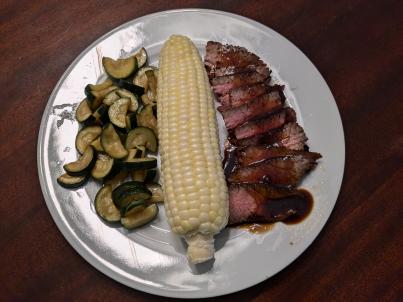
Yoshida Sauce
- 2 cups soy sauce
- ¾ cup brown sugar
- ¾ cup sugar
- 2 cloves garlic, chopped
- 8 slices ginger
- 8 scallions, diced
- 1 cup honey or agave syrup
Combine soy sauce, both sugars, garlic, ginger, and scallions in a pot,
then bring to a simmer for 15 minutes while stirring occasionally.
Remove from heat, then strain out solids and return to pot.
Add honey or agave syrup, then bring to a boil until foamy.
Remove from heat and chill.
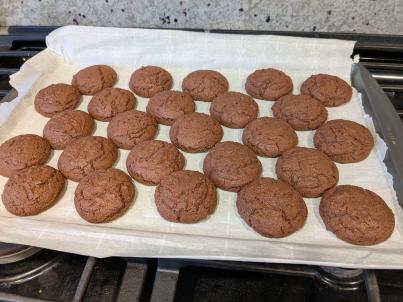
Chocolate Cookies
- 1 cup butter
- 1 cup sugar
- 1 cup brown sugar
- 1 tsp vanilla
- 2 eggs
- ¾ tsp salt
- 1 tsp baking soda
- ⅓ cup cocoa powder
- 3½ cups flour
Cream butter until soft, then add both sugars, creaming until
light. Add vanilla and eggs and mix thoroughly.
Combine salt, baking soda, cocoa powder, and flour, and add
to butter mixture in thirds, mixing until combined after
each addition.
Form into 1" rough balls of dough and set on a baking tray
about 2" apart, then freeze dough balls for at least 2 hours.
There will be about 50 cookies.
Preheat oven to 375°F.
Bake for 12 minutes and let cool at least 5 minutes before
eating.
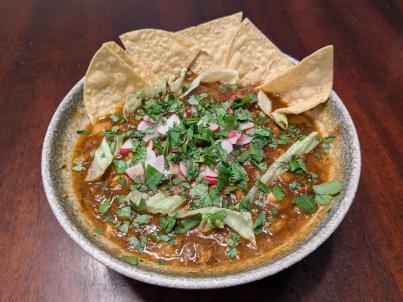
Pozole
Soup
- 3 lbs boneless pork
- 1½ tsp salt
- ¾ tsp pepper
- 5 tsp cumin
- 110 oz hominy
- 1 14.5 oz can of chicken broth
- 1 cup water
- 2 bay leaves
- 5 tsp oregano
- 3 cloves garlic
- 2 onions, chopped
- 9 Tbsp adobo sauce
Adobo Sauce
- 10 ancho chile peppers
- 5-8 mulato chile peppers
- 3-4 guajillo chile peppers
- 1 20 oz can chipotles in adobo sauce
- 1⅔ cups boiling water
Preheat oven to 400°F.
For each type of pepper, open all the peppers and remove the
seeds and stems, laying the peppers out flat on a baking sheet.
Bake for only a few minutes, anywhere from 4-12 depending on
peppers' moisture level. Not all peppers will be done at the same
time. Finished peppers will be just starting to smoke, and still
pliable but only slightly.
Allow peppers to cool; they will become dry and brittle. Break
peppers up by hand while adding to a blender or spice grinder,
then pulverize to a powder.
These amounts of peppers will produce about 50 g ancho chile
powder, 20 g mulato chile powder, and 15
g guajillo chile powder.
Combine chipotles in adobo sauce, hot water, and chile powders
in a blender, then purée until smooth. The exact amount of chile
powder to use varies slightly, but the objective is to just
slightly overtake the tomato flavor from the canned adobo
sauce with the smokiness and fruitiness from the toasted chiles.
Trim pork, then cut into 1-2" pieces. Combine salt, pepper, and
cumin, then use to coat pork and sear in a small amount of oil.
Drain hominy and add liquid to seared pork, along with chicken
broth, water, bay leaves, and oregano. Bring to a boil.
Reduce heat, skim any foam if necessary, then add garlic, onion,
and adobo sauce. Simmer covered for about an hour. Add hominy,
increase heat, then cook uncovered for several hours more.
Serve with tortilla chips, chopped lettuce, sliced radish, lime
juice, and avocado.

Italian Meatballs
Meatballs
- 4 eggs
- 1 cup bread crumbs
- 1 cup red wine
- 2 Tbsp grated parmesan cheese
- 2 tsp crushed garlic
- 2 Tbsp parsley
- 2 tsp oregano
- 1 tsp rosemary
- 1 tsp basil
- 1 lb ground beef
- 3 lbs Italian sausage
Sauce
- 4 28 oz cans crushed tomatoes
- 1 6 oz can tomato paste
- 1 15 oz can tomato sauce
- 1½ cups red wine
- 2 Tbsp parsley
- 2 Tbsp oregano
- ½ tsp rosemary
- ½ tsp basil
- ½ tsp thyme
- ¼ tsp pepper
- ¼ tsp red pepper flakes
Preheat oven to 400°F.
Combine all sauce ingredients, using wine to rinse tomato
cans. Mix thoroughly, and set on medium heat to simmer.
Combine all meatball ingredients other than meats, and mix
thoroughly. Add meats and mix until well incorporated.
Portion out into individual meatballs, about 4 tsp each,
and roll until round. There will be about 100
meatballs when done correctly.
Bake for 10-12 minutes, then add to sauce.
When sauce is heated to steaming, reduce heat to low and
continue simmering for several hours, stirring occasionally
to raise meatballs from bottom of pot; liquids will collect
above and must be recombined.
Serve over spaghetti, or in meatball subs. Freezes well.
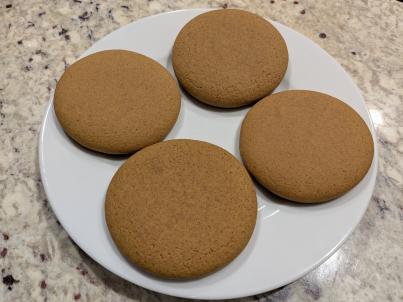
Gingerbread Cookies
- 1 cup butter
- 1 cup sugar
- 1¼ cups molasses
- 2 eggs
- ¼ tsp salt
- 1 tsp baking soda
- ½ tsp cloves
- ½ tsp nutmeg
- 1 tsp cinnamon
- 2 Tbsp ginger
- 6 cups flour
Cream butter until soft, then add sugar, creaming until
light. Add molasses and eggs and mix thoroughly.
Combine salt, baking soda, spices, and flour, and add to
butter mixture in thirds, mixing until combined after each
addition. Chill, covered, for at least 2 hours.
Preheat oven to 350°F.
Dust work surface with flour, then roll out dough to about
7-10 mm thick, applying additional flour as necessary to
prevent sticking. Punch out cookie shapes with cookie cutters
or an inverted glass, setting cookies on a baking tray.
Knead extra dough back together and refrigerate for 10-20
additional minutes before repeating to make more cookies.
Bake for 9 minutes and let cool completely before decorating.
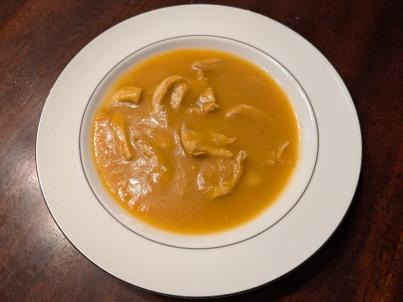
Chicken Soup
- ⅝ gallon water
- 3 chicken bouillon cubes
- ¼ tsp MSG
- 1 chopped onion
- 16 oz chopped carrots
- 2 cups finely chopped celery
- 1½-2 lbs chicken
- 1 14.5 can of chicken broth
In a large pot, combine water, bouillon cubes, and MSG, then
add onion, carrots, and celery. The celery should be chopped
to pieces no longer than 1 cm or so, to avoid long strings in
the final soup. Bring to a simmer.
In a sauté pan, sear the chicken in a small amount of neutral
oil, until just cooked through and a crust forms. Remove from
pan and let cool, then deglaze pan with chicken broth. Add
broth to vegetables, then roughly tear chicken into small
pieces once cool.
When vegetables are softened, about 30 minutes, remove from
broth and blend with enough broth to fully purée, then return
to pot. Removing vegetables is easier without adding batches
of blended vegetables back to pot until all vegetables are
removed.
Add chicken pieces to blended vegetable broth and bring to
a boil, then allow to simmer for another 10 minutes or so to
allow all flavors to combine.
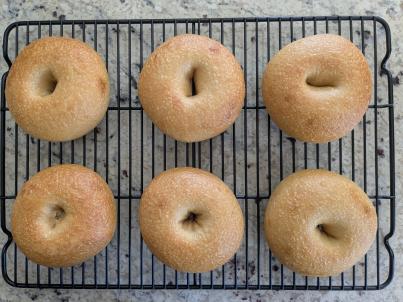
Bagels
- 2 cups water
- 736 g (about 5¾ cups) bread flour
- 2½ tsp malted barley syrup
- ½ cup warm water
- 11½ g yeast
- 22½ g salt
- 288 g (about 2¼ cups) bread flour
- ½ gallon water
- 2 Tbsp malted barley syrup
In a large mixing bowl, combine water and flour, mix until
combined, then cover and let sit for 20-60 minutes.
Make an impression in the center of the dough, then add malt
syrup, about half in the impression and half outside. Add
warm water in the impression, then stir in the yeast. Let
bloom for about 5 minutes, then add salt and remaining flour
and begin kneading in the remaining flour.
Continue kneading for at least 15-20 minutes; bagel dough
must be extensively kneaded for the right final texture. If
the dough seems at all sticky, add more flour until it just
barely sticks to itself - the drier the dough, the taller
the bagels will be. Cover and let rise until doubled, about
1-2 hours.
Punch down and divide into 12 smooth balls.
Cover and let rest for about 30 minutes.
Lightly grease 2 sheet pans. Form each ball
into a ring shape by gently punching a hole in the center
and stretching into a ring, and arrange with plenty of
clearance to expand. Cover and let rise at room temperature
for about 30 minutes, or chilled for 12-24 hours. The long,
cold rise tastes better.
Preheat oven to 375°F and set a shallow tray of about
½ cup water inside.
Bring water to a boil in a wide pot and add malt syrup to
make a caramel colored solution. Boil the bagels for about
30 seconds on each side, then remove to a wire rack to dry
off. Bake on parchment paper until golden and crispy, about
19-20 minutes, rotating about 5 minutes before finished.





















































